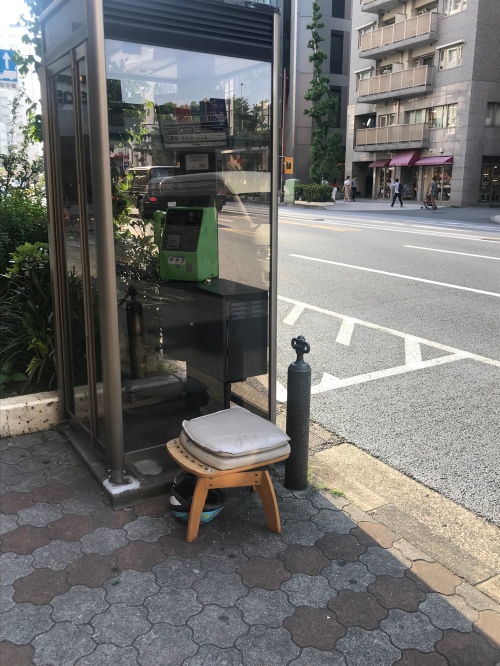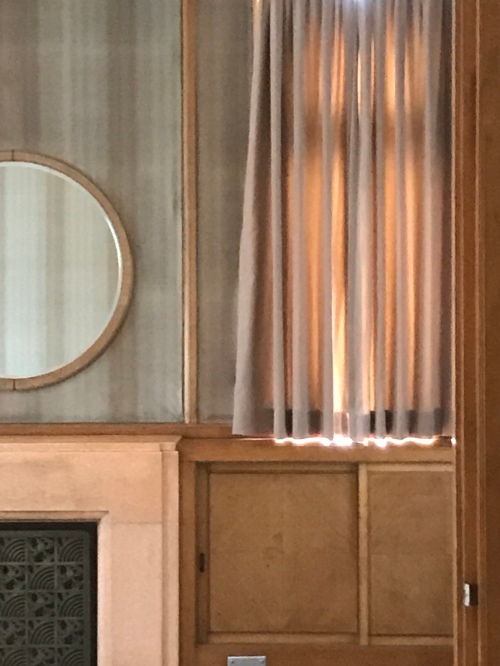



Meandering in Meguro, Tokyo, yesterday – an area we don’t know – in the hot sun, the first full day of summer, the pounding light






we came across an exhibition by an artist we had never heard of – Moise Kissling – at a gallery and building we had never heard of either : the Tokyo Metropolitan Teien Art Museum.
Its grounds inviting – we could see families and young lovers politely picnicking on the grass, children running from pools of light to shade – we decided to buy tickets.

Hypnotic in the afternoon, we rested on a bench for a while watching the quiet play of the respectful, almost hushed members of the public recreationing on the premises

– the sound of the elevated highway beyond the perimeter low, but constant against the foreground of bird song, voices, and insects.
Couples in kimono took pictures

and we took took pictures of them

before beginning to feel, after a while, like entering the interior cool of the prim, but not uninviting, white building that housed the paintings, and drawings, of the unknown artist.

Ice cold airconditioning did not detract from the gelid attractiveness of the Art Deco mansion, which it quickly transpired was the former royal home of Prince Asaka and his family in the 1930s, who had relocated to Meguro after a three year stay in Paris, where they were inspired by all things European, thus building their homage – Lalique windows inside; crystalled, spreading angels of glass filtering trellises – but you were not allowed to take pictures of them

( the royal toilet )
– never have I known a more anally retentive, almost furiously passive aggressive museum, where a surfeit of security guards and waxen, bloodless women guided you with swift and disciplined hand; gritted chin, through the ‘suggested route’, admonishing you if your clammed skin should graze against the walls or railings or furniture ( the claustrophobic, mahogany childhood bedrooms of sequestered and cloistered princelings and maids and childrens’ books a perfect setting, in some ways, for Kissling’s Modigliani-like portraits of the rich and the decadent alienated ; some quite brilliant, particularly when he found his own voice; many of flowers – peonies, mimosa – some too lavish and almost tacky, others oil painted in splashes of colour that offset the lonely dreams of the imperial ancestry, cosseted in their European blue lace, their lives foregrounded by duty, protocol, and expectation .)
*
Intriguingly, the young princesses even had a magnificent, if slightly grotesque, almost Hollywoodesque perfume fountain in the atrium of the palace ( what a delight ! To fragrance the ambience when guests would arrive in the drawing room to dine or listen to string quartets !)

( this you were mysteriously allowed to photograph, but each exhibit was obsessively and maniacally divided into those you could, and those – the majority – you could not )

( ‘Portrait of a Fascist Perfume Fountain with Stiff’, Neil Chapman, Saturday May 25th, 2019).
Yet much as we enjoyed the aesthetic culmination of the artworks and the cold precision of the setting, after a time, the silent reverence and absurd REPRESSION of the place had me bursting at the seams (I could not refrain from goosestepping like a Nazi after a while and contaminating the place with my scent and my foul language, much to Duncan’s hysteric)

– the fittings and furnishings on some levels pleasing my sensibilities even when they simultaneously made me want to SCREAM


–
even when confronted with undeniable beauty :
( the exquisite tea house : rendered by me here in black and white ):

No, by this point we had to leave – my blood was beginning to heat up in protest with all the security guards and almost vicious courteousness, and I had started joking about lobbing grenades.


Retiring to a bench on the way to the exit, delighted to be pawed and leached by the four O clock sun (let it RAIN on me after all that sphinctered insularity !)
we decided to find out more about Prince Asaka and the house ( as you know: when we visit somewhere, be it Laos, Cambodia, Korea, anywhere) we do no research:: just go, absorb, feel, observe, and then get all the ‘factual information’ later – I find this a more valid form of experience, more immersed and honest; unprejudiced. You experience it pure.
And it turns out my instincts, on this occasion, were undoubtedly very right : with its heavy, small rooms devoid of sufficient light (poor children!); its design, some of which reminded me of Mussolini’s Cinecitta futurist district in Rome in its mathematical concision; this, it turns out, was the royal house of the hyper nationalist imperialist, and (alleged/probable) instigator of the Nanking Massacre ( an INCREDIBLY contentious issue here you cannot talk about in public: a subject as full of fury as the most ardent Holocaust deniers …..I might even get into trouble daring to touch on the subject here…..) – a person who,anywhere else, would have been executed as the worst kind of war criminal, but who instead, went on to live freely, at his leisure, playing golf for many years in Atami.
Leaving the environs behind us,

I couldn’t help, despite the beautiful, searing blue sky, thinking of the ‘dark clouds of fascism’ that were brooding and percolating then in the race- hate-filled hearts of the many who were plotting to bayonet and decapitate the founts of our liberty, and the currents of now, not dissimilar: isolationist, ‘patriotic’; ultra-conservative, founded on limitation, control, ethnic hatred…………ironically, cruelly; and problematically, given the setting of the exhibition it occurred to me later (would the painter really have wanted his works to have been presented in this place?) – precisely what Kissling – a Bohemian Polish Jew who managed to escape with his life to America and then France, given a death sentence by the Nazis, but who instead went on to his freedom and to make some beautiful and riveting art, – was so utterly desperate – and determined, to escape.






































































